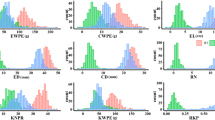Abstract
Evaluation of combining ability is a crucial process in hybrid breeding, and dissection of the genetic basis of combining ability will facilitate hybrid breeding. In this study, molecular markers significantly associated with general combining ability (GCA) of seven yield-related traits and the traits per se were detected in a set of maize introgression lines (ILs) under three environments. Totally 25 and 31 significant loci for GCA and the traits per se were commonly detected under multiple environments, respectively. Correlation analysis and comparison among these significant loci revealed that the genetic basis of GCA of these yield-related traits was generally different from that of the traits per se except for the trait of ear row number. In addition, GCA of the ILs was positively and significantly correlated to the total relative effects of significant GCA loci in the ILs in general, implying that the GCA loci identified in this study would be useful in molecular breeding. Correlation analysis also showed that the GCA of yield per plant was strongly correlated to the GCA of kernel number per row, ear length and 100-kernel-weight, thus these traits were more important in genetic improvement for GCA. Results in this study would provide useful information for hybrid breeding in maize.
Similar content being viewed by others
Abbreviations
- EH:
-
Ear height
- EL:
-
Ear length
- GCA:
-
General combining ability
- ILs:
-
Introgression lines
- KN:
-
Kernel number per row
- KW:
-
100-Kernel weight
- PH:
-
Plant height
- QTL:
-
Quantitative trait loci
- RN:
-
Row number
- YP:
-
Yield per plant
References
Austin DF, Lee M, Veldboom LR, Hallauer AR (2000) Genetic mapping in maize with hybrid progeny across testers and generations: grain yield and grain moisture. Crop Sci 40:30–39
Basbag S, Ekinci R, Gencer O (2007) Combining ability and heterosis for earliness characters in line × tester population of Gossypium hirsutum L. Hereditas 144:185–190
Eichten SR, Foerster JM, Leon N, Kai Y, Yeh C, Liu S, Jeddeloh JA, Schnable PS, Kaeppler SM, Springer NM (2011) B73-Mo17 near-isogenic lines demonstrate dispersed structural variation in maize. Plant Physiol 156:1679–1690
Eshed Y, Zamir D (1995) An introgression line population. Genetics 141:1147–1162
Griffing B (1956) Concept of general and specific combining ability in relation to diallel crossing systems. Aust J Biol Sci 9:463–493
Gu L (2007) General combining ability analysis and its QTL mapping of maize DH lines. Dissertation, Heibei Agricultural University
Hallauer AR (1990) Methods used in developing maize inbreds. Maydica 35:1–6
Hallauer AR, Carena MJ, Miranda-Filho JB (2010) Quantitative genetics in maize breeding. Springer Science + Business Media, New York
Keurentjes JJB, Bentsink L, Alonso-Blanco C, Hanhart CJ, Vries HB, Effgen S, Vreugdenhil D, Koornneef M (2007) Development of a near-isogenic line population of Arabidopsis thaliana and comparison of mapping power with a recombinant inbred line population. Genetics 175:891–905
Liu X, Chen S, Chen J, Ishiki K, Wang W, Yu L (2004) Improvement of combining ability for restorer lines with the identified SSR markers in hybrid rice breeding. Breed Sci 54:341–346
Liu R, Zhang H, Zhao P, Zhang Z, Liang W, Tian Z, Zheng Y (2012) Mining of candidate maize genes for nitrogen use efficiency by integrating gene expression and QTL data. Plant Mol Biol Rep 30:297–308
Lv AZ, Zhang H, Zhang Z, Tao Y, Yue B, Zheng Y (2012) Conversion of the statistical combining ability into a genetic concept. Agric Sci China 11:101–111
Ni X, Zhang T, Jiang K, Yang L, Yang Q, Cao Y, Wen C, Zheng J (2009) Correlations between specific combining ability, heterosis and genetic distance in hybrid rice. Hereditas (Beijing) 31:849–854
Nyquist WE (1991) Estimation of heritability and prediction of selection response in plant populations. Crit Rev Plant Sci 10:235–322
Pradesh H (1998) General combining ability and its repeatability in early generations of potato breeding programmes. Potato Res 41:21–28
Qi H, Huang J, Zheng Q, Huang Y, Shao R, Zhu L, Zhang Z, Qiu F, Zhou G, Zheng Y, Yue B (2013) Identification of combining ability loci for five yield-related traits in maize using a set of testcrosses with introgression lines. Theor Appl Genet 126:369–377
Qu Z, Li L, Luo J, Wang P, Yu S, Mou T, Zheng X, Hu Z (2012) QTL mapping of combining ability and heterosis of agronomic traits in rice backcross recombinant inbred lines and hybrid crosses. PLoS ONE 7:e28463
Riedelsheimer C, Czedik-eysenberg A, Grieder C, Lisec J, Technow F, Sulpice R, Altmann T, Stitt S, Willmitzer L, Melchinger AE (2012) Genomic and metabolic prediction of complex heterotic traits in hybrid maize. Nat Genet 44:217–220
SAS Institute Inc (2002) SAS guide for personal computers, 9th edn. SAS Institute, Cary
Smith JSC, Hussain T, Jones ES, Graham G, Podlich D, Wall S, Williams M (2008) Use of doubled haploids in maize breeding: implications for intellectual property protection and genetic diversity in hybrid crops. Mol Breeding 22:51–59
Stuber CW, Lincoln SE, Wolff DW, Helentjaris T, Lander ES (1992) Identification of genetic factors contributing to heterosis in a hybrid from two elite maize inbred lines using molecular markers. Genetics 132:823–839
Teng W, Cao J, Chen Y, Liu X, Jing X, Zhang F, Li J (2004) Analysis of maize heterotic groups and patterns during past decade in China. Scientia Agricultura Scinica 37:1804–1811
Acknowledgments
This work was financially supported by the National Natural Science Foundation of China (No: 30971791), Fundamental Research Funds for the Central Universities (Program No: 2012ZYTS055), and Hubei Provincial Natural Science Foundation (No: 2010CBB01902). The authors also thank Dr. Zuxin Zhang for kindly providing the seeds of the ILs.
Author information
Authors and Affiliations
Corresponding author
Additional information
Juan Huang and Huanhuan Qi have contributed equally to this work.
Rights and permissions
About this article
Cite this article
Huang, J., Qi, H., Feng, X. et al. General combining ability of most yield-related traits had a genetic basis different from their corresponding traits per se in a set of maize introgression lines. Genetica 141, 453–461 (2013). https://doi.org/10.1007/s10709-013-9744-3
Received:
Accepted:
Published:
Issue Date:
DOI: https://doi.org/10.1007/s10709-013-9744-3



